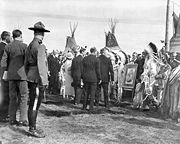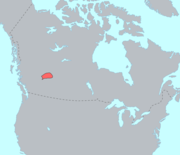
Nakoda (people)
Encyclopedia



First Nations
First Nations is a term that collectively refers to various Aboriginal peoples in Canada who are neither Inuit nor Métis. There are currently over 630 recognised First Nations governments or bands spread across Canada, roughly half of which are in the provinces of Ontario and British Columbia. The...
group, indigenous to both Canada
Canada
Canada is a North American country consisting of ten provinces and three territories. Located in the northern part of the continent, it extends from the Atlantic Ocean in the east to the Pacific Ocean in the west, and northward into the Arctic Ocean...
and, originally, the United States
United States
The United States of America is a federal constitutional republic comprising fifty states and a federal district...
.
They used to inhabit large parts of British Columbia
British Columbia
British Columbia is the westernmost of Canada's provinces and is known for its natural beauty, as reflected in its Latin motto, Splendor sine occasu . Its name was chosen by Queen Victoria in 1858...
, Alberta
Alberta
Alberta is a province of Canada. It had an estimated population of 3.7 million in 2010 making it the most populous of Canada's three prairie provinces...
, Saskatchewan
Saskatchewan
Saskatchewan is a prairie province in Canada, which has an area of . Saskatchewan is bordered on the west by Alberta, on the north by the Northwest Territories, on the east by Manitoba, and on the south by the U.S. states of Montana and North Dakota....
, and Montana
Montana
Montana is a state in the Western United States. The western third of Montana contains numerous mountain ranges. Smaller, "island ranges" are found in the central third of the state, for a total of 77 named ranges of the Rocky Mountains. This geographical fact is reflected in the state's name,...
, but their reserves are now located in Alberta and in Saskatchewan where they are scarcely differentiated from the Assiniboine. Through their language they are related to the Dakota and Lakota nations of the Great Plains
Great Plains
The Great Plains are a broad expanse of flat land, much of it covered in prairie, steppe and grassland, which lies west of the Mississippi River and east of the Rocky Mountains in the United States and Canada. This area covers parts of the U.S...
and the Rocky Mountains
Rocky Mountains
The Rocky Mountains are a major mountain range in western North America. The Rocky Mountains stretch more than from the northernmost part of British Columbia, in western Canada, to New Mexico, in the southwestern United States...
, part of the large Sioux
Sioux
The Sioux are Native American and First Nations people in North America. The term can refer to any ethnic group within the Great Sioux Nation or any of the nation's many language dialects...
Nation.
They refer to themselves in their own language as "Nakoda", meaning friend, ally. The name "Stoney" was given them by white explorers, because of their technique of using fire-heated rocks to boil broth in rawhide bowls, also with vegetables. The vegetables just gave the soup more flavor. They are very closely related to the Assiniboine who are also known as Stone Sioux (from Ojibwe
Ojibwe language
Ojibwe , also called Anishinaabemowin, is an indigenous language of the Algonquian language family. Ojibwe is characterized by a series of dialects that have local names and frequently local writing systems...
asinii-bwaan).
Alberta's Nakoda First Nation comprises three bands: Bearspaw
Bearspaw First Nation
The Bearspaw First Nation is a First Nations government or band of the Nakoda people.In November 2010, a dispute arose when the chief of the band, David Bearspaw, cancelled a forthcoming election and extended his term by two years, prompting a protest blockade of the Eden Valley 216 reserve by...
, Chiniki and Wesley.
Stoney groups
The Stoney are descendants of individual bands of DakotaSioux
The Sioux are Native American and First Nations people in North America. The term can refer to any ethnic group within the Great Sioux Nation or any of the nation's many language dialects...
, Lakota and Nakota
Nakota
The term Nakota is the endonym used by the native peoples of North America who usually go by the name of Assiniboine , in the United States, and of Stoney, in Canada....
, in particular of western groups of Assiniboine, from which they spun out as an independent group at about 1744. The Stoney were divided geographically and culturally into two tribal groups or divisions with different dialects, which in turn were further divided into several bands:
Wood Stoney (Chan Tonga Nakoda- ‘Big Woods People’, often called Swampy Ground Assiniboine, northern tribal group)
- Alexis' band (Stoney, Métis, Woodland CreeCreeThe Cree are one of the largest groups of First Nations / Native Americans in North America, with 200,000 members living in Canada. In Canada, the major proportion of Cree live north and west of Lake Superior, in Ontario, Manitoba, Saskatchewan, Alberta and the Northwest Territories, although...
) - Paul's bandPaul BandThe Paul First Nation, more commonly known as the Paul Band, is a First Nation community or band based in Wabamun, Alberta of mixed Cree and Nakota origin. They are party to Treaty Six and had the Buck Lake Indian Reserve 133C and Wabamun Lake Indian Reserve 133A, 133B and 133C allocated to them...
(Danezaa, Stoney, Woodland Cree, IroquoisIroquoisThe Iroquois , also known as the Haudenosaunee or the "People of the Longhouse", are an association of several tribes of indigenous people of North America...
)
Mountain Stoney (Ye Xa Yabine Nakoda or Hebina - ‘Rock Mountain People’, often called Strong Wood Assiniboine, Thickwood Assiniboine, southern tribal group)
- Wesley's (Goodstoney's) band (Stoney, Plains CreeCreeThe Cree are one of the largest groups of First Nations / Native Americans in North America, with 200,000 members living in Canada. In Canada, the major proportion of Cree live north and west of Lake Superior, in Ontario, Manitoba, Saskatchewan, Alberta and the Northwest Territories, although...
, Métis, Kutenai) - Chiniki's band (MétisMétisA Métis is a person born to parents who belong to different groups defined by visible physical differences, regarded as racial, or the descendant of such persons. The term is of French origin, and also is a cognate of mestizo in Spanish, mestiço in Portuguese, and mestee in English...
, Stoney, Plains Cree, SecwepemcSecwepemcThe Secwepemc , known in English as the Shuswap people, are a First Nations people residing in the Canadian province of British Columbia. Their traditional territory ranges from the eastern Chilcotin Plateau and the Cariboo Plateau southeast through the Thompson Country to Kamloops and the Shuswap...
, Kutenai) - Bearspaw's band (Stoney, Cree)
- Sharphead's band (Chipos Ostikwan's Nakoda, Wolf Creek Stoney or Pigeon Lake Stoney, often called Plains Assiniboine) (Stoney, Métis)
Treaties
Members of the Nakoda nations of Paul and AlexisAlexis Nakota Sioux First Nation
The Alexis Nakota Sioux Nation no. 437 is a Nakoda First Nation which reserves near Edmonton, Hinton, and Whitecourt, in the Canadian province of Alberta, and headquartered at 54° N and 114°, about west of Edmonton...
signed an adhesion to Treaty 6
Treaty 6
Treaty 6 is an agreement between the Canadian monarch and the Plain and Wood Cree Indians and other tribes of Indians at Fort Carlton, Fort Pitt and Battle River. The area agreed upon by the Plain and Wood Cree represents most of the central area of the current provinces of Saskatchewan and...
in 1877.
In 1877, representatives of the Nakoda Nations of Bearspaw, Chiniki and Wesley met with representatives of the British Crown to discuss the terms of Treaty 7
Treaty 7
Treaty 7 was an agreement between Queen Victoria and several mainly Blackfoot First Nations tribes in what is today the southern portion of Alberta. It was concluded on September 22, 1877. The agreement was signed at the Blackfoot Crossing of the Bow River, at the present-day Siksika Nation...
. In exchange for use of traditional native lands, the Crown agreed to honor their right to self-government and an ancestral way of life. They were also promised reserve
Indian reserve
In Canada, an Indian reserve is specified by the Indian Act as a "tract of land, the legal title to which is vested in Her Majesty, that has been set apart by Her Majesty for the use and benefit of a band." The Act also specifies that land reserved for the use and benefit of a band which is not...
lands, 279 km² situated along the Bow River
Bow River
The Bow River is a river in the Canadian province of Alberta. It is a tributary of the South Saskatchewan River, and is considered the headwater of the Nelson River....
between the Kananaskis River
Kananaskis River
The Kananaskis River is a mountain river in western Alberta, Canada. It is a tributary of the Bow River, crossing the length of Kananaskis Country.The river was named by John Palliser in 1858 after a Cree.-Course:...
and the Ghost River, which became the Big Horn
Big Horn 144a
Big Horn 144a is an Indian reserve in Alberta....
, Stoney and Eden Valley
Eden Valley 216
Eden Valley 216 is an Indian reserve located near Longview, Alberta. It is shared by the Bearspaw, Chiniki, and Wesley bands of the Nakoda nation.-References:...
reserves
Indian reserve
In Canada, an Indian reserve is specified by the Indian Act as a "tract of land, the legal title to which is vested in Her Majesty, that has been set apart by Her Majesty for the use and benefit of a band." The Act also specifies that land reserved for the use and benefit of a band which is not...
, shared between the Bearspaw, Chiniki and Wesley tribes.
See also
- Sioux languageSioux languageSioux is a Siouan language spoken by over 33,000 Sioux in the United States and Canada, making it the fifth most spoken indigenous language in the United States or Canada, behind Navajo, Cree, Inuit and Ojibwe.-Regional variation:...
- NakotaNakotaThe term Nakota is the endonym used by the native peoples of North America who usually go by the name of Assiniboine , in the United States, and of Stoney, in Canada....
- First Nations in AlbertaFirst Nations in AlbertaFirst Nations in Alberta constitute several dozen nations. Reserves of these First Nations were established in Alberta by a series of treaties, Treaty 6, Treaty 7, and Treaty 8....
- List of Alberta Indian reserves
- stoney first nation culture

